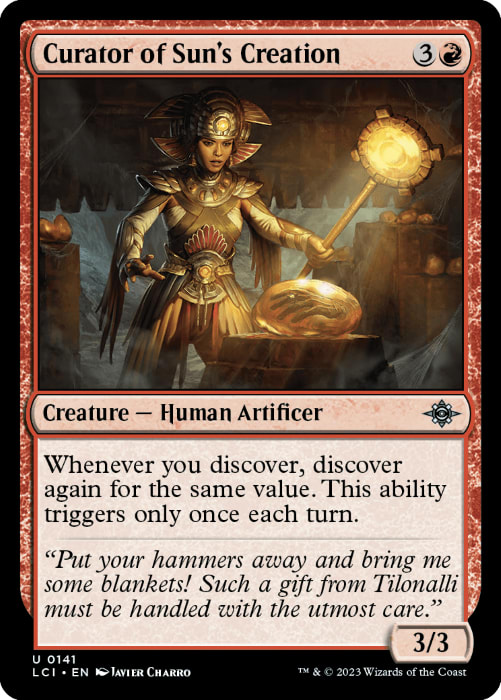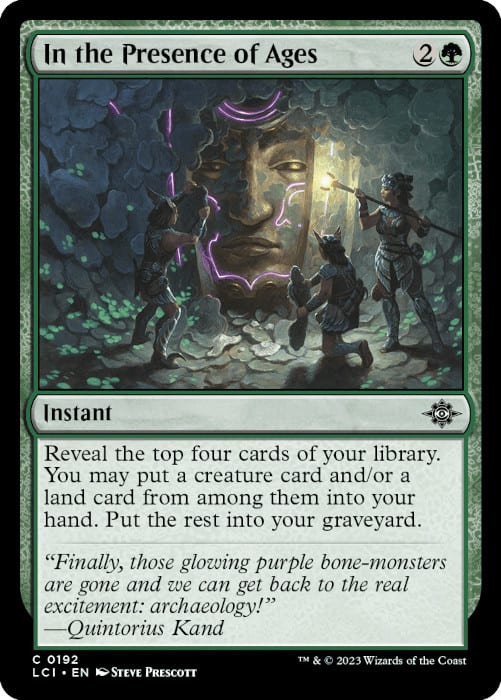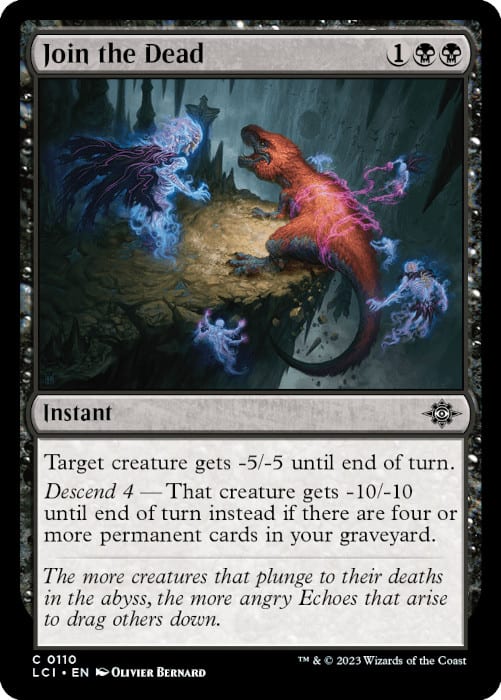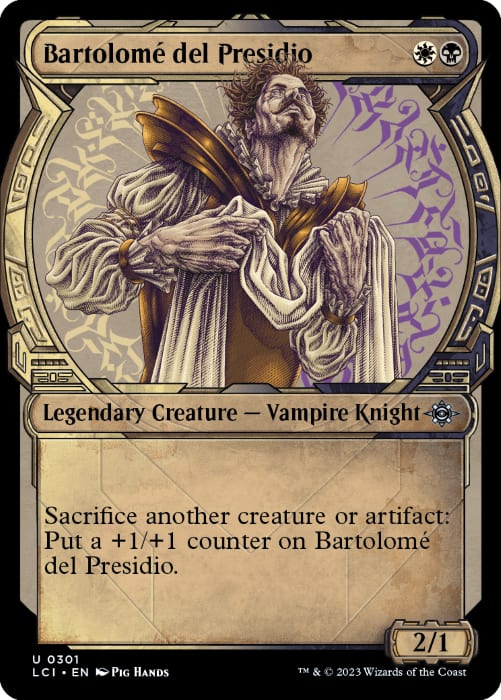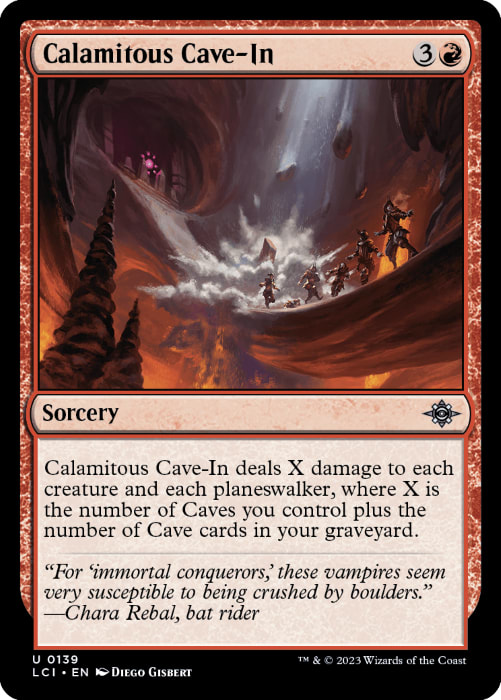The Lost Caverns of Ixalan is an odd Draft format.
In many ways, it seems to draw comparisons back to popular formats like Kamigawa: Neon Dynasty and Dominaria United, with a fairly wide spread of different themes being cross-supported in unique and interesting ways that allow cards to fulfill roles in multiple archetypes.
This sort of "open world" design for a limited format is usually incredible, as the replayability is off the charts as you are constantly putting the Lego pieces into different combinations and getting to experiment with different ways to make things work. This is in contrast to formats that feel more on rails, where the archetypes are linear and don't play well together, so you just pick one of the themes and draft all the cards of that theme and most decks end up looking the same.
Looking at the card list for The Lost Caverns of Ixalan, there's a lot of synergy-based stuff that makes it feel like it's going to be an awesome sandbox-style format, with all sorts of synergy cards and mechanical crossover. Unfortunately, it doesn't completely succeed at this goal, due to some imbalance among the archetypes, as well the outright failure of a few of them, as well as the speed that some of the better decks get to operate at.
That still being said, while it may not be an all-time great format, there's still a lot to do and a lot of fun to be had drafting The Lost Caverns of Ixalan!
Today I'm going to break down the key aspects of the format I learned while drafting up to mythic rank on MTG Arena on my show Bronze to Mythic, breaking the format down into it's three major parts: Jeskai Artifacts, Sultai Graveyard, and the other stuff. Let's go!
Jeskai - Artifacts
It's important to note here that when I say Jeskai (which is of course, Blue, White, and red), I don't mean draft decks that are all three colors, but rather all of the possible two-color pairs among the trio.
All three of these color pairs are among the most winning in the format, as the artifact theme is strongly woven through each of them. Whether it's treasure tokens, map tokens, or gnome tokens, all three colors excel at putting a lot of stuff in play and using it effectively, which is why any card that makes multiple permanents is a major draw. Many of the good cards are just already artifacts as well, meaning you don't have to work that hard at turning on your synergies.
Boros
While Boros is and can be aggressive, it's more so just a "put a bunch of cardboard into play" type of deck in this format. The main theme is based around tapping two artifacts or creatures to do things, which obviously plays well with having a bunch of stuff in play. Because of this and the reach cards like Sunshot Milita give you, the deck can afford to sit back a little more and close the games out with abilities or equipment rather than be pure aggression.
Azorius
Azorius is the most controlling of the trio, with a ton of excellent long game cards like Master's Guide-Mural and Clay-Fired Bricks. This is not to say that Azorius isn't interested in attacking; fliers like Runelurker Bat and Waterwind Scout are still excellent here, but Azorius also has the ability to go later into games as well with a ton of great craft cards that provide card advantage as well as finishing power after the initial push.
And that's not all, as Azorius also just has a secret archetype of "a bunch of fliers" that works wonders too, letting the color pair be aggressive or more controlling as needed thanks to stuff like Miner's Guidewing, Oltec Cloud Guard and Spyglass Siren. This can be a great place to lean if it feels like the colors are somewhat open but the artifact cards are being too hotly contested.
Izzet
Surprisingly, the most aggressive of the three artifact archetypes is Izzet, which is probably the fastest deck in the format. Almost every pirate card is aggressively slated via way of artifacts, which leads the way for fast, synergistic curve outs backed up by removal. With explore, map tokens, and card filtering, the deck starts quickly but also doesn't really run out of gas, and that's to say nothing of the many high quality rares and uncommons available to the archetype.
While the path for each of the three different Jeskai color combos diverge a little, they're all coming from the same place which makes it easy to start any draft down any of the paths knowing you can swerve a little to either side and still be well set up. Your highest priorities are:
- Keep your mana curve low low low
- Overvalue cards that make multiple permanents
- Make sure your cards fit the goals of your deck; defensive cards like Spring-Loaded Sawblades aren't going to go well in your aggressive decks, just like purely offensive cards like Hotfoot Gnome aren't going to play well in your more defensive decks. Make sure your cards serve the purpose of your deck
Sultai - Graveyard
And then we come to the other "half" of the format in Sultai (Blue, Green, Black), and it's not nearly as smooth sailing as the Jeskai decks.
Most of the artifact stuff happening in the Jeskai colors is happening pretty painlessly. There are plenty of good cards that just happen to be artifacts, and cards that make extra material like map tokens or treasure tokens don't need much help to be good, they're just intrinsically good, and any additional artifact synergy ends up being a bonus.
On the other hand, the main mechanic across the Sultai colors is descend, which cares about cards being in or going to the graveyard. This is much more difficult to access than the more generic artifact synergies, requiring actual set up for payoffs that aren't always worth the squeeze. The enablers are slow and awkward on average, and most of the non-rare payoffs just aren't that great. There's also the issue that one of the better mechanics for slow decks is craft, which specifically removes cards from your graveyard, creating anti-synergy among the cards you can play.
This often leaves the graveyard decks a little slow and a little awkward, which is not a great place to be against the fast, well-oiled machine that is most of the artifact decks. It also is a count against these decks that Black is the universal graveyard color and often the base of these decks, but has perhaps the weakest commons of all the colors.
Golgari
Golgari is often the best graveyard-matters pair in most formats, and while it certainly works here, it suffers from lack of depth at common in both colors. Black just has a bunch of mediocre commons that masquerade as decent enablers or payoffs like Screaming Phantom or Deep Goblin Skulltaker but just don't get it done.
And then you have half of the Green commons caring about dinosaurs and having no synergy with the graveyard stuff at all. There is some crossover like Pathfinding Axejaw, as well as some cards like Mineshaft Spider that are excellent for the archetype, but for the most part there isn't a lot to go off of.
Dimir
Dimir is the best of the three graveyard pairs, mostly propped up by how good the Blue commons and uncommons are. There's a ton of exploring happening in Blue at excellent rates, both via explore triggers as well as map tokens, and the card advantage pairs well with Black's removal in longer games.
If you want to do long game graveyard control stuff, Blue/Black is where it's at.
There's also a secret reanimator deck in Dimir, similar to the controlling descend decks but using Defossilize and Soulcoil Viper to return the land cycling dinosaurs like Marauding Brinefang to the battlefield ahead of schedule.
Simic
And then we come to Simic.
Straight Blue/Green simply doesn't function as a graveyard deck without Black. Black provides both the removal and recursion necessary to play longer games in this format, meaning it is very difficult to properly use your graveyard and take the game long without it.
Instead, Blue/Green is framed as the explore deck, but with the only real payoff for explore being Nicanzil, Current Conductor (Merfolk Cave-Diver is hardly playable), and the fact that all the explore cards are just really good cards on rate without any help means that this archetype lacks any focus at all.
It's not as easy as the artifact deck, but you can put together a successful descend deck by doing the following:
- Play as many permanent cards as possible; ideally, you'll have 2 or 3 very high-quality spells, but everything else will be a permanent
- Focus on defensive self-mill plays like Mineshaft Spider and Deathcap Marionette that enable your graveyard stuff but also play to the board
- Keep the curve low, cheap removal like Dead Weight is key
- A bomb creature in the Sultai colors is a great reason to start down this path, as you see so much of your deck and there's a lot of recursion, so you should be able to find it most games
The Others
If your analysis of the format simply stopped at Jeskai = artifacts and Sultai = graveyard, you'd honestly have a very good grasp of what is going on, but there are four color pairs left we haven't discussed, as well as the hidden 11th archetype.
One important thing to note however before we get to those is that Blue is the best color in this format and it's somewhat obvious why-- it's the one color in both of the three-color mixes, meaning it has synergy with both artifact stuff and graveyard stuff, something the other color pairs lack as they're only good at one or the other, as we will see. This means that Blue cards are a phenomenal place to start your drafts because they can go so many different directions.
Gruul
Aside from the Jeskai and Sultai color pairs, the only other pair with a clear and successful theme is Gruul with dinosaurs. Forget artifacts, don't worry about your graveyard, just draft big rate creatures and smash face.
There honestly isn't a ton of synergy here and there doesn't need to be. Sure, Itzquinth, Firstborn of Gishath gets to bite things and Earthshaker Dreadmaw might draw a card or two, but realistically you're playing the Gruul cards because they're good on rate and get the job done, while sidestepping the needs of the other archetypes.
That being said, be aware that most of the good dinosaurs are at uncommon, so you'll want to make sure this archetype is open for getting in to it.
Beyond Gruul, things get very murky.
Selesnya
There sorta isn't really an actual archetype for Selesnya.
Kutzil, Malamet Exemplar speaks to the idea of pumping your creatures for synergy and profit, as well as being an excellent card, but there just aren't many other actual payoffs for this theme beyond just having larger creatures to smash face with. This means that Selesnya is pretty much just a pump spells and fliers aggro deck, which is fine considering the power of the White fliers.
Again, no artifact or graveyard synergy here, just keep the curve super low and make sure you've got ways to push through.
Orzhov
Orzhov is supposed to be the sacrifice deck, but the problem is that Black and White have opposing viewpoints.
Black is in the descend trio, meaning it cares about the graveyard and stuff dying, therefore it wants to see it's permanents go away. White is in the artifact trio, which is all about having a bunch of stuff in play, so it does not want to see its permanents go away. See the issue?
There also just aren't enough good things to sacrifice, nor good bonuses for sacrificing things, making Orzhov one of the worst decks in the format.
Rakdos
Rakdos is very similar, with Red standing in for White but still wanting the same things.
More specifically, Rakdos is looking to descend every turn, thereby putting cards in the graveyard and triggering all of its descend effects. The problem is that, for the most parts, the enablers and the payoffs aren't good for this. There are just too many three and four mana commons that are trying to do these jobs, but they do so at an unacceptable rate, meaning that when your deck fails, it really fails bad.
This makes Rakdos one of the worst-performing archetypes in the format.
Caves
Lastly, there's caves.
Frankly, aside from Calamitous Cave-In, the juice isn't worth the squeeze.
Unlike the gates deck from Ravnica Allegiance, the caves are not also good mana fixing lands like Gruul Guildgate. Quite the contrary, many of them are just colorless. This, coupled with the fact that every color only has one pretty good to very good uncommon that cares about caves at all, means that actually assembling a functional caves deck is quite difficult.
Don't think of caves as a full archetype, but rather a subtheme you can dip into aside from your main theme to maybe splash a card or two off of. The discover common caves are all excellent, as is Captivating Cave, and when you throw Compass Gnome and Scampering Surveyor into the mix you can get away with playing five or six caves and a payoff or two in an otherwise "normal" looking deck.
Putting It All Together
To recap:
- One of the Jeskai artifacts pairs is the goal, but you can go elsewhere if it isn't open
- Recognize which elements of your colors are working together and which ones are fighting each other, and try to hedge towards the ones that work together
- Even if you aren't drafting an aggressive deck, recognize that your opponents will be so you need to keep your mana curve low and defend yourself early
- If either the artifact or graveyard archetype doesn't seem open, Gruul or Selesnya are your likely outs for the non-archetype decks
- Splashing isn't easy given the mana fixing in this set and the speed decks can clock you with, so be careful with it
- Pretty much every one-drop in this set is playable to excellent, so unlike most Limited formats many games will be starting on turn one... be ready!
One of the best things about drafting is its self-correcting nature. Even the formats that aren't perfect have a chance to course correct, but it's also important that you understand the rules of engagement as well.
The Lost Caverns of Ixalan draft certainly has some specific rules, but once you follow them there's definitely a lot of fun stuff to do!


















